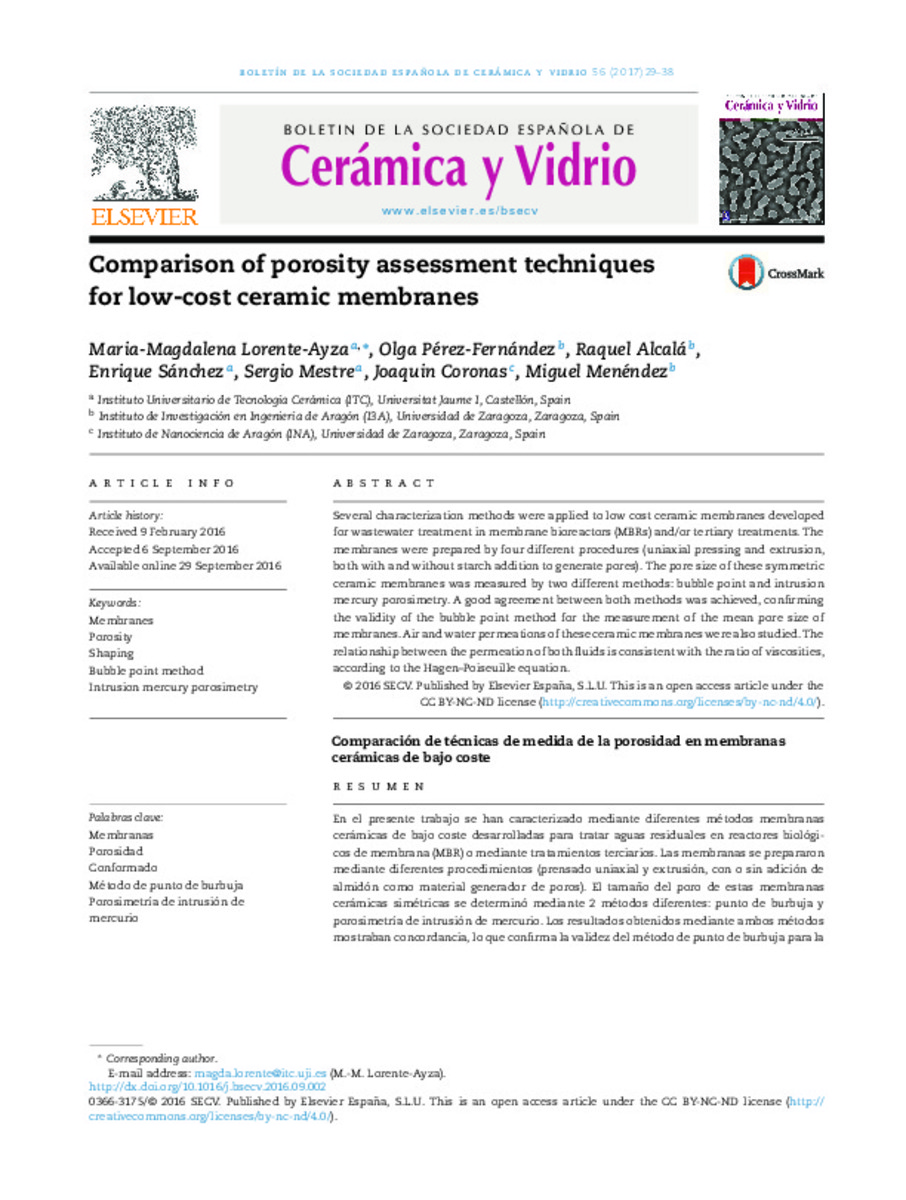Mostrar el registro sencillo del ítem
Comparison of porosity assessment techniquesfor low-cost ceramic membranes
| dc.contributor.author | Lorente Ayza, Maria Magdalena | |
| dc.contributor.author | Pérez-Fernández, Olga | |
| dc.contributor.author | Alcalá, Raquel | |
| dc.contributor.author | Sánchez-Vilches, Enrique | |
| dc.contributor.author | Mestre Beltrán, Sergio | |
| dc.contributor.author | Coronas, Joaquin | |
| dc.contributor.author | Menéndez, Miguel | |
| dc.date.accessioned | 2017-03-01T12:27:49Z | |
| dc.date.available | 2017-03-01T12:27:49Z | |
| dc.date.issued | 2017-01 | |
| dc.identifier.citation | LORENTE-AYZA, Maria-Magdalena, et al. Comparison of porosity assessment techniques for low-cost ceramic membranes. Boletín de la Sociedad Española de Cerámica y Vidrio, 2016. | ca_CA |
| dc.identifier.uri | http://hdl.handle.net/10234/166382 | |
| dc.description.abstract | En el presente trabajo se han caracterizado mediante diferentes métodos membranas cerámicas de bajo coste desarrolladas para tratar aguas residuales en reactores biológicos de membrana (MBR) o mediante tratamientos terciarios. Las membranas se prepararon mediante diferentes procedimientos (prensado uniaxial y extrusión, con o sin adición de almidón como material generador de poros). El tamaño del poro de estas membranas cerámicas simétricas se determinó mediante 2 métodos diferentes: punto de burbuja y porosimetría de intrusión de mercurio. Los resultados obtenidos mediante ambos métodos mostraban concordancia, lo que confirma la validez del método de punto de burbuja para la medida del tamaño del poro medio de las membranas. Además, se ha estudiado la permeabilidad al aire y agua de estas membranas cerámicas: la relación entre la permeabilidad de ambos fluidos es consistente con el ratio de viscosidades, de acuerdo con la ecuación de Hagen-Poiseuille. | ca_CA |
| dc.description.abstract | Several characterization methods were applied to low cost ceramic membranes developed for wastewater treatment in membrane bioreactors (MBRs) and/or tertiary treatments. The membranes were prepared by four different procedures (uniaxial pressing and extrusion, both with and without starch addition to generate pores). The pore size of these symmetric ceramic membranes was measured by two different methods: bubble point and intrusion mercury porosimetry. A good agreement between both methods was achieved, confirming the validity of the bubble point method for the measurement of the mean pore size of membranes. Air and water permeations of these ceramic membranes were also studied. The relationship between the permeation of both fluids is consistent with the ratio of viscosities, according to the Hagen–Poiseuille equation. | ca_CA |
| dc.description.sponsorShip | This paper includes results of the NITRAMEM (IPT-2012-0069-310000) project, funded with a total amount of 870,455.39 Euros by the Ministry of Economy and Competitiveness and the European Regional Development Fund (ERDF) of the European Union, INNPACTO through the program, which the authors show their gratitude. | ca_CA |
| dc.format.extent | 10 p. | ca_CA |
| dc.format.mimetype | application/pdf | ca_CA |
| dc.language.iso | eng | ca_CA |
| dc.publisher | Sociedad Española de Cerámica y Vidrio | ca_CA |
| dc.relation.isPartOf | Boletín de la Sociedad Española de Cerámica y Vidrio Volume 56, Issue 1, January–February 2017 | ca_CA |
| dc.rights | © 2016 SECV. Published by Elsevier España, S.L.U. | ca_CA |
| dc.rights | Atribución-NoComercial-SinDerivadas 4.0 España | * |
| dc.rights.uri | http://creativecommons.org/licenses/by-nc-nd/4.0/ | * |
| dc.subject | Membranes | ca_CA |
| dc.subject | Porosity | ca_CA |
| dc.subject | Shaping | ca_CA |
| dc.subject | Bubble point method | ca_CA |
| dc.subject | Intrusion mercury porosimetry | ca_CA |
| dc.subject | Membranas | ca_CA |
| dc.subject | Porosidad | ca_CA |
| dc.subject | Conformado | ca_CA |
| dc.subject | Método de punto de burbuja | ca_CA |
| dc.subject | Porosimetría de intrusión de mercurio | ca_CA |
| dc.title | Comparison of porosity assessment techniquesfor low-cost ceramic membranes | ca_CA |
| dc.type | info:eu-repo/semantics/article | ca_CA |
| dc.identifier.doi | http://dx.doi.org/10.1016/j.bsecv.2016.09.002 | |
| dc.rights.accessRights | info:eu-repo/semantics/openAccess | ca_CA |
| dc.relation.publisherVersion | http://www.sciencedirect.com/science/article/pii/S0366317516300723 | ca_CA |
Ficheros en el ítem
Este ítem aparece en la(s) siguiente(s) colección(ones)
-
QUI_Articles [296]








